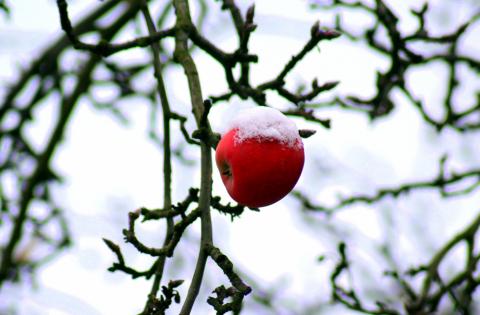Do fluctuating winter temperatures hurt fruit trees?

Widely fluctuating winter temperatures are becoming all too familiar to New Hampshire residents. While a January thaw may be nice for us, you might be wondering what it does to fruit trees and other landscape plants.
All of the fruit trees that can be grown in New Hampshire have a dormancy mechanism within them that keeps them from growing in the middle of the winter. In the fall, when they stop growing and drop their leaves, trees enter a period of rest dormancy (endodormancy) to protect themselves from the cold.
This dormant period is only broken after the tree has experienced a certain amount of “chilling hours,” which are the cumulative number of hours when the temperature drops between 32 and 45℉. How many chilling hours are required to break dormancy varies widely between species of plants and even between cultivated varieties of a tree. For example, apples need to experience between 800 and 1750 hours of temperatures below 45 degrees to break a rest period. This chilling requirement keeps trees from starting to grow in midwinter despite intermittent above-average temperatures or mid-winter thaws.
Once a tree has experienced its requisite chilling hours, it will begin to break dormancy, and new leaf and flower buds will start to swell. Once the buds start growing, the tree can no longer readjust to the cold. Extreme cold will cause injury to the buds, which is why fruit trees are sometimes damaged by a late frost, freeze or extreme cold. The shorter a tree’s chilling hour requirements, the more likely it is to be damaged by winter conditions. This is one of the reasons peaches can be so difficult to grow in NH, needing between 375 and 1000 chill hours.
Similarly, many ornamental trees in the landscape also have chilling hour requirements. These numbers aren’t documented like they are for fruit trees, but they still exist. As a general rule, native plants have higher chilling hour needs, so they break dormancy without the risk of their flower or leaf buds being damaged. That’s why it’s important to select hardier cultivars of plants such as magnolias or Eastern redbud.
As spring approaches and many trees reach their chilling hour requirements, keep your fingers crossed for no extremely cold temperatures. If the weather cooperates, expect plentiful blooms on your fruit trees this spring.
Got questions? The Ask UNH Extension Infoline offers practical help finding answers for your home, yard, and garden questions. Call toll free at 1-877-398-4769, Monday to Friday, 9 a.m. to 2 p.m., or e-mail us at answers@unh.edu.
Do you love learning about stuff like this?
SUBSCRIBE TO Granite State Gardening newsletter
Got questions? The UNH Extension Yard and Garden Infoline offers practical help finding answers for your yard and garden questions.
Call toll free at 1-877-398-4769, Monday to Friday, 9 a.m. to 2 p.m., or fill out webform.
